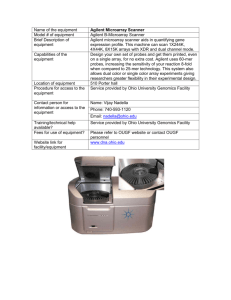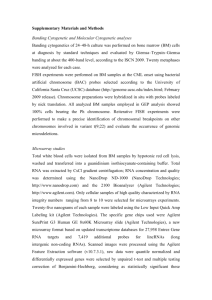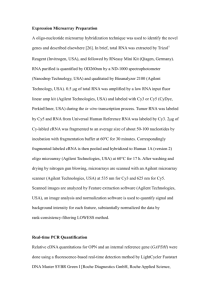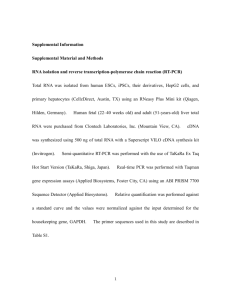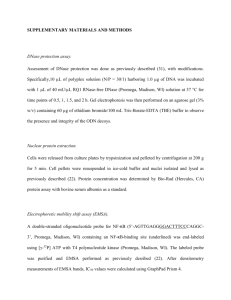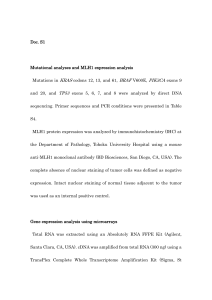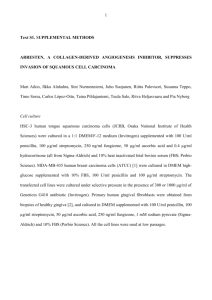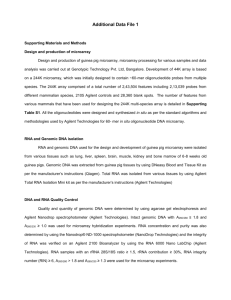Supplementary Methods and Materials Cell proliferation assay and c
advertisement
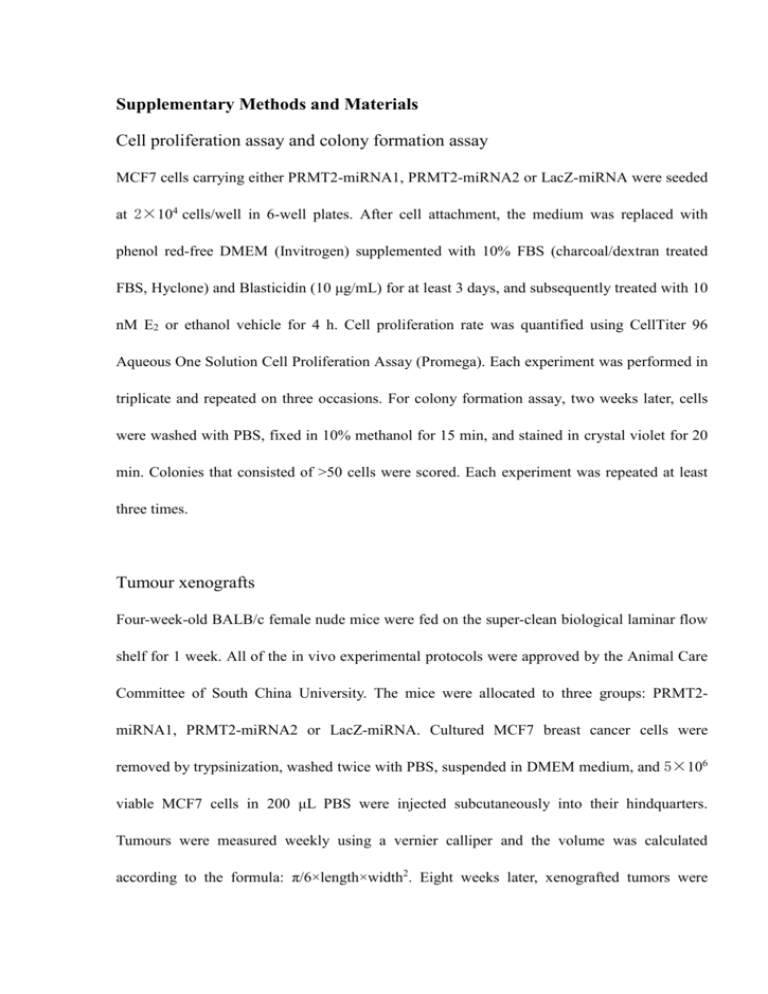
Supplementary Methods and Materials Cell proliferation assay and colony formation assay MCF7 cells carrying either PRMT2-miRNA1, PRMT2-miRNA2 or LacZ-miRNA were seeded at 2×104 cells/well in 6-well plates. After cell attachment, the medium was replaced with phenol red-free DMEM (Invitrogen) supplemented with 10% FBS (charcoal/dextran treated FBS, Hyclone) and Blasticidin (10 μg/mL) for at least 3 days, and subsequently treated with 10 nM E2 or ethanol vehicle for 4 h. Cell proliferation rate was quantified using CellTiter 96 Aqueous One Solution Cell Proliferation Assay (Promega). Each experiment was performed in triplicate and repeated on three occasions. For colony formation assay, two weeks later, cells were washed with PBS, fixed in 10% methanol for 15 min, and stained in crystal violet for 20 min. Colonies that consisted of >50 cells were scored. Each experiment was repeated at least three times. Tumour xenografts Four-week-old BALB/c female nude mice were fed on the super-clean biological laminar flow shelf for 1 week. All of the in vivo experimental protocols were approved by the Animal Care Committee of South China University. The mice were allocated to three groups: PRMT2miRNA1, PRMT2-miRNA2 or LacZ-miRNA. Cultured MCF7 breast cancer cells were removed by trypsinization, washed twice with PBS, suspended in DMEM medium, and 5×106 viable MCF7 cells in 200 μL PBS were injected subcutaneously into their hindquarters. Tumours were measured weekly using a vernier calliper and the volume was calculated according to the formula: π/6×length×width2. Eight weeks later, xenografted tumors were collected, dissected, and fixed in formalin (10%) for 24 hrs and stored in 70% ethanol at 4°C. Tumors were processed at the histology facility to prepare paraffin embed tissues and multiple section slides. Global cDNA microarray analysis and target gene verification Total RNA was extracted from MCF7 cells carrying either PRMT2-miRNA1 or LacZ-miRNA. Each sample was quantified using the NanoDrop ND-1000 and the RNA integrity was assessed using standard denaturing agarose gel electrophoresis. The sample preparation and microarray hybridization were performed based on the manufacturer’s standard protocols. Briefly, total RNA from each sample was amplified and transcribed into fluorescent cRNA with using the manufacturer’s Agilent’s Quick Amp Labeling protocol (version 5.7, Agilent Technologies). The labeled cRNAs were hybridized onto the Whole Human Genome Oligo Microarray (4x44K, Agilent Technologies). After having washed the slides, the arrays were scanned by the Agilent Scanner G2505C. Agilent Feature Extraction software (version 11.0.1.1) was used to analyze acquired array images. Quantile normalization and subsequent data processing were performed using the GeneSpring GX v11.5.1 software package (Agilent Technologies). After quantile normalization of the raw data, genes that at least 3 out of 3 samples have flags in detected were chosen for further data analysis, and the spot with ≥2.0-fold increase or decrease was considered a significant change. Differentially expressed genes were identified through fold-change screening. Real-Time RT-PCR Isolated RNA was reverse transcribed using SuperScript II reverse transcriptase (Invitrogen). The primers for the target genes are listed in Table S1. Quantitative measurement of target gene mRNA levels was performed by ABI Prism 7900 (Applied Biosystems, USA). These data were analyzed by the comparative Ct method. The PCR reactions were initiated with incubation at 95°C for 10 min, followed by 40 cycles of 95°C, 10 s and 60°C, 60 s. For each reaction, standard curves for the reference gene were constructed by using seven tenfold serial dilutions of PCR product. All samples were run in triplicate and reported as target gene expression levels relative to GAPDH in the cells. Electrophoretic mobility shift assay The full-length human recombinant PRMT2 protein was purchased from abnova. Nuclear extract was extracted using NucBuster Extraction Kit (Novagen). Biotin end-labeled AP-1 probe was synthesized by Invitrogen. biotin-top, 5'-Biotin-CGC TTG ATG ACT CAG CCG GAA-Biotin-3'; biotin-bottom, 5'-Biotin-TTC CGG CTG AGT CAT CAA GCG-Biotin-3'. Electrophoretic mobility shift assay (EMSA) was done as the procedure of LightShift Chemiluminescent EMSA Kit (Thermo Scientific). Briefly, biotinlabeled probe (100 fM or 200 fM) and 20-μg nuclear extract prepared from MCF-7 cells were incubated for 20 minutes at room temperature. Free probe was separated from DNA-protein complexes by electrophoresis on a native 6% polyacrilamide gel in ×0.5 TBE buffer. After electrophoresis, the DNA was transferred to positively charged nylon membrane, cross-linked, and detected by chemiluminescence.
